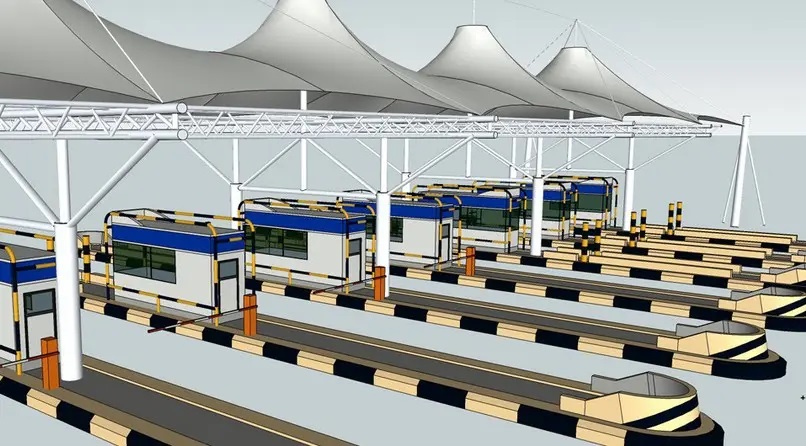With the rapid development of economy, the number of urban traffic roads has been increasing, and the number of motor vehicles and road traffic flow has increased significantly. In order to create a good urban traffic environment and improve urban traffic conditions, relying solely on manual toll collection can no longer meet the needs of modern traffic management. Under this premise, it is imperative to improve the modernization level of highway and urban traffic management, and it is urgent to adopt high-tech means to enrich and strengthen the level of traffic management.
The expressway toll collection system is an important part of expressways
and a channel for expressway owners to recover their investment. The expressway toll collection system generally adopts a four-level toll collection system of "toll lane - toll station - toll center of each operating company - toll settlement center".

Expressways generally have one or more toll management centers, toll booths, toll plazas and toll lanes (including exit lanes and entry lanes). There is a computer local area network in the toll center and each toll station.The charging center is responsible for managing the charging work of each charging sub-center within its jurisdiction, and at the same time accepts the management of the charging general center.Toll sub-centers accept the management of higher-level toll centers, and are also responsible for the management and monitoring of toll stations within their jurisdiction.
In reality, the highway toll station is a bottleneck, which is easy to cause traffic congestion, which not only prolongs the travel time, but also increases carbon dioxide emissions. As a result, transportation authorities around the world require highways to implement no-stop toll collection (ETC) systems to stabilize the traffic flow on highways. ETC toll stations are equipped with laser detectors, license plate recognition, and electromagnetic induction light technology to determine vehicle information, which is used to detect vehicle models, violations, vehicle owner information, balance, etc. ETC keeps highway roads clear, reducing travel times and greenhouse gas emissions.
The overall demand for Industrial Switches in expressway toll system:
1. Adopt industrial grade design, adapt to the harsh environment in the toll station, including temperature, humidity, dustproof, shockproof, anti-electromagnetic interference and other requirements.
2. The overall network is real-time and reliable, with high-speed ring network redundancy and self-healing capabilities, which can realize remote management of equipment and alarm of equipment failures.
3. The product has stable performance, long-term durability, low failure rate, easy system construction and installation, and convenient later operation and maintenance management.
4. The open industrial-grade Ethernet design has good scalability and compatibility, and can be integrated with other network system applications in the toll station.
5. Large flow, high bandwidth, provide stronger network load capacity, realize stable transmission of charging data, and ensure uninterrupted network data transmission.
6. The time for toll collection stations to collect the toll data generated by the lanes under its jurisdiction should be ≤0.5s, the average waiting time for the toll station to issue system parameters to the lanes should be ≤60s, and the time for uploading the lane operation information to the toll station database should be ≤1s
HouShi Industrial Switch Solutions
In a single expressway toll station, a redundant ring topology is formed by using the thick stone IS2000 high-speed dedicated industrial switch to ensure that each node detecting vehicle information has at least 2 paths to the local server to avoid the impact of link failure on the toll system. Each toll station uses multiple gigabit optical fiber interfaces to cascade IS5000 core industrial switches in the management center for uploading toll data and downloading vehicle update database.
IS2000 and IS5000 industrial switches not only have MAC binding and IP binding technology to protect server security, but also have QINQ technology that can achieve VLAN duplication on highways and difficult management.The ultra-short forwarding delay technology between the ports of the industrial switch can quickly respond to toll requests, improve the speed of electronic toll collection, and maximize the throughput rate of expressways.
The advantages of Our industrial switch solutions
1. The port delay is less than 10μm, and the delay jitter is less than 1μm
2. EMC Class 4 industrial design, providing independent dual redundant protection power input
3.QINQ technology, easy to deal with complex VLAN planning of expressways
4. Fanless cooling, green, environmentally friendly, ultra-low power consumption design
5. Oversized backplane, ultra-high cache, extremely fast response to authentication request packets
6. Security measures such as hardware storm suppression, port binding, and 802.1x
7. Preprocessing response, extremely fast caching technology, to improve the speed of vehicle traffic
Contact: sales
Phone: 18688787693
E-mail: sales@hsindustrialswitch.com
Add: Room 608, Building B,GaoXinQi TEC Park,Baoan District, ShenZhen,China